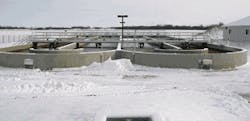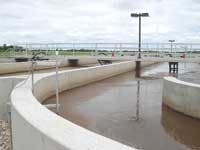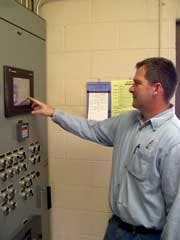Brent Powers, Maintenance Superintendent for Dawson, monitors the DO levels in the oxidation ditch from the plant control room.
Click here to enlarge imageThe current DO set point in the ditches is 2.0 ppm. A minimum of one process aerator/mixer is always in operation to maintain mixing and aeration in the basin. If the DO levels drop below 2.0 ppm a second unit is automatically turned on. A third unit is turned on if DO levels drop below 1.5 ppm and a fourth unit is turned on if the DO levels drop below 1.0 ppm. The PLC also monitors which units are in operation and rotates operating units once a day to insure all units have a similar total operational run time.
Brent Powers, Maintenance Superintendent for the city of Dawson, said more units are typically needed in operation in the summer when water temperatures are 65-75 degrees Fahrenheit versus the winter when water temperatures are 40-45 degrees.
“Typically the DO levels measured in the basin require one process aerator/mixer unit for operation in the winter and two units in the summer with the third unit turning on and off in the summer as the influent load (and hence oxygen demand) fluctuates during the day,” Power said.
Currently the process controls are set up to turn off entire process aerator/mixer units. Due to the design of the units, more finite control can be implemented if the application requires higher mixing velocities but not as much aeration by automatically turning off the individual blower units.
Operation of the new oxidation ditch has resulted in a substantial electrical savings when compared to the original ditch that was installed at the plant. The operating water level of the original ditch installed in 1973 was only 4 feet. The ditch used brush rotor technology for aeration and mixing. Two brush rotors were installed. Each brush rotor motor was 25 hp and both units needed to operate continuously to supply the proper amount of mixing in the ditch.
With the new deeper oxidation ditch, more efficient process aerator/mixer units, and DO process controls, the city of Dawson can now realize average annual electrical savings of over $15,000 by only using the amount of mixing and aeration required by the process. Moreover, power dispersion to multiple, more efficient and smaller process aerator/mixer units around the ditch allows for operational rotation of the units and system redundancy, thereby simplifying operations and extending the life of the equipment.
The oxidation ditch has been operating well with very little attention required from the operators. Experience dictates that the membrane on the DO sensors must be cleaned once or twice a month to maintain consistent DO readings. This is an easy procedure involving removal of any material that may have wrapped itself around the end of the probe and wiping off the sensor’s membrane to remove any biological growth that may affect the readings. The DO membrane itself needs to be replaced about twice a year. Plant effluent results have been excellent, averaging 3 mg/l CBOD5, 8 mg/l TSS, and 0.1 mg/l ammonia.
Automatic process control using DO sensors and PLC programming to monitor and control the operation of the process aerator/mixer units has allowed the city of Dawson to keep tight control over their treatment process. Implementation of the process control system has improved plant performance and saved the city money at the same time.
About the Author
Shawn Brown is the Systems Product Manager for Aeration Industries International Inc. and holds a B.S. in Chemical Engineering from Virginia Tech. He has worked as an engineer in the OEM sector of the water and wastewater industry for over 12 years. Brown may be contacted by phone at 952-556-5706 or by email at [email protected].





